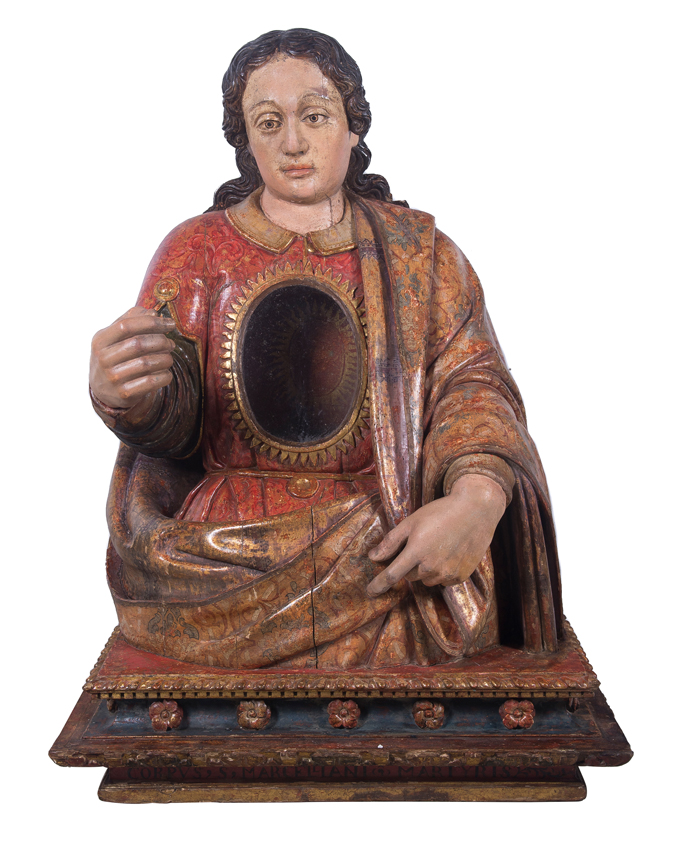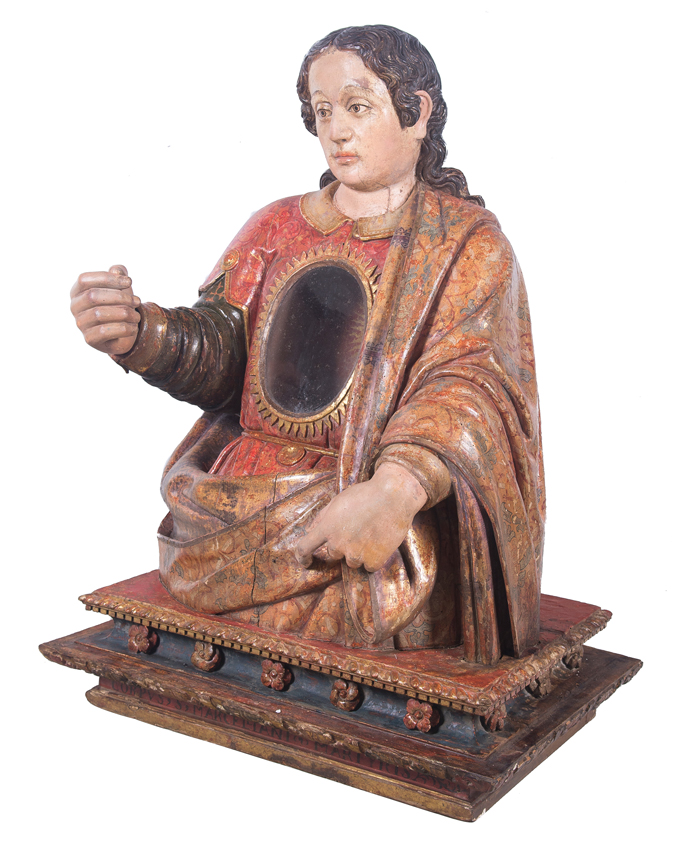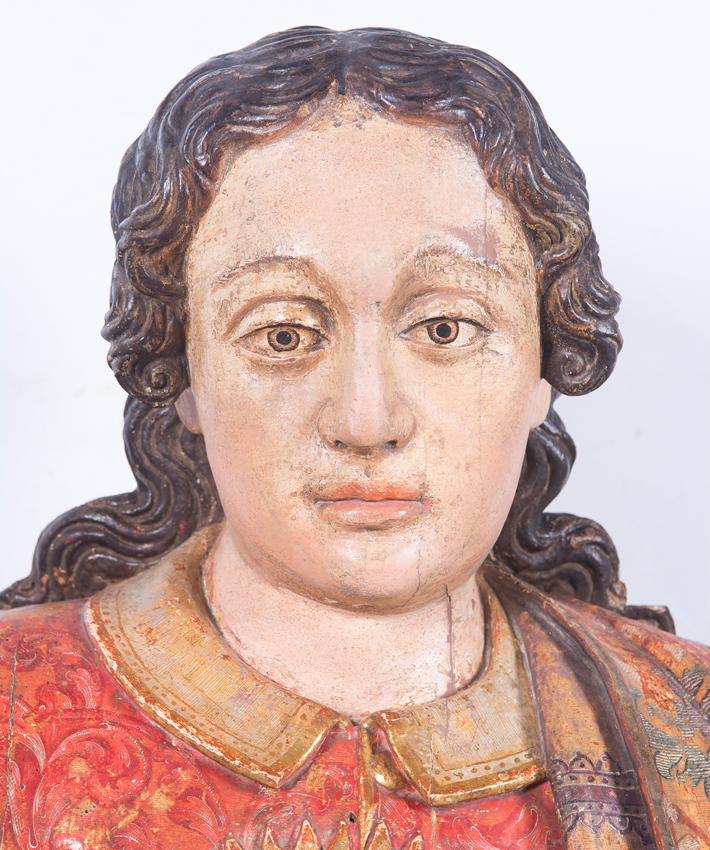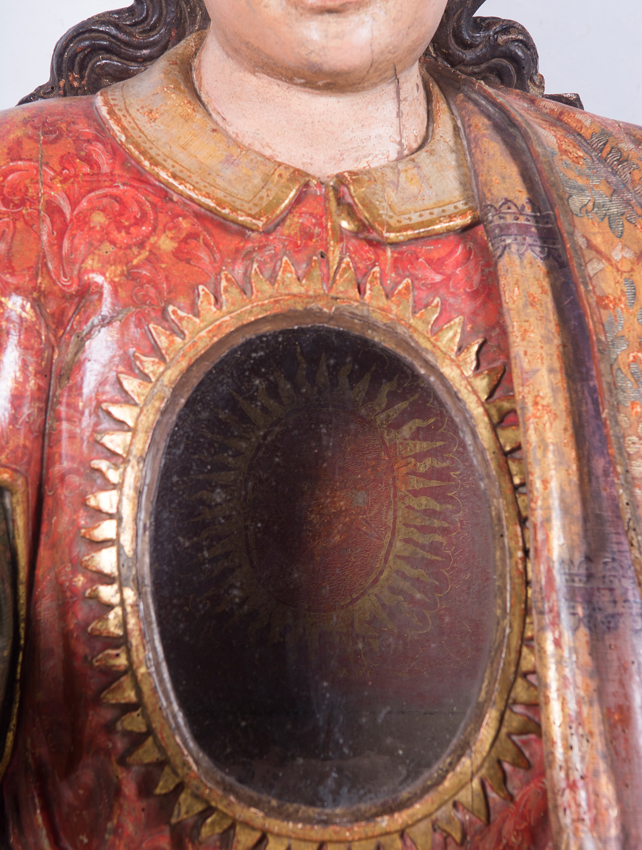65
Castilian school. Second quarter of the 17th century.
Castilian school. Second quarter of the 17th century.
"Reliquary bust of San Marceliano"
Carved, polychromed and gilded wooden sculpture.
110 x 80 x 66 cm.
This lot came from importation, so it has guaranteed export license from the Spanish Ministry of Culture.
The Council of Trent (1545-1563) made a clear decision to promote the worship of martyr saints as a reaffirmation of the dogma of faith in the Communion of Saints, a doctrine which also affected the veneration of relics and images of them. It was defined in the 25th session of the Council, held during the year 1563, which led to the rejection of Protestant teaching on this point. Officially it was established that bishops should instruct the faithful: “Also, that the holy bodies of holy martyrs, and of others now living with Christ,-which bodies were the living members of Christ, and the temple of the Holy Ghost, and which are by Him to be raised unto eternal life, and to be glorified,--are to be venerated … through which many benefits are bestowed by God on men; so that they who affirm that veneration and honour are not due to the relics of saints… are wholly to be condemned …by the decrees of Councils, and especially of the second Synod of Nicaea… defined against the opponents of images.”
At the same time, on the other hand, provisions were adopted to avoid doctrinal errors and abuses of practices: "Moreover, in the invocation of saints, the veneration of relics, and the sacred use of images, every superstition shall be removed, all filthy lucre be abolished… And that these things may be the more faithfully observed, the holy Synod ordains...[that no] new relics [be] recognised, unless the said bishop has taken cognizance and approved thereof "
The bust we present is an exceptionally unique piece due to its colossal size, which may indicate that it presided over a reliquary altarpiece. It is a speaking reliquary bust dedicated to the martyr Saint Marcellian, as indicated by an inscription located on the interior part of the pedestal: "CORPVS S. MARCELLIANI MARTYRIS." Saint Marcellinus, whose story is always linked to that of his twin brother Saint Marcellus, was a deacon venerated as a saint who suffered martyrdom during the persecutions against Christians ordered by Emperor Diocletian. Both were martyred in a forest, and their remains were buried on the Via Ardeatina, near the Domitilla Catacombs.
The bust, resting on a rectangular double-height pedestal decorated with rosettes in its middle part, has a monumental character, presenting the saint from just below the waist, allowing the cord that tightens his tunic around the waist to be observed. It has an oval-shaped head slightly inclined to the right. The face has a somewhat indifferent expression, with almond-shaped eyes fixed on the infinite, a strong nose with noticeably flared nostrils, a closed mouth composed of fleshy, tight lips, and a slight double chin. The saint has long classical-looking and symmetrically styled hair, with numerous wavy locks falling on both sides of the face and at the back, ending in coils. The anonymous sculptor has meticulously carved each of these locks.
On the chest, there is an oval-shaped shrine surrounded by golden rays and closed within a glass panel - the original one placed when the piece was crafted - which would have protected the relics ex ossibus housed inside and belonging to the depicted saint. Inside, painted on the background, we see another oval shape emitting alternating curved and straight golden rays. This motif may have had a purely decorative function, although it cannot be ruled out that it contained the relic or relics for which the reliquary bust was made.
The saint raises his right hand, between the fingers of which, as mentioned earlier, he would have held an attribute or perhaps a martyr's palm, which unfortunately has been lost, while the other hand is brought to his mantle, as if wanting to gather it while extending his index finger.
The other hand is directed towards the mantle, as if wanting to pick it up while having the index finger extended. The bust is dressed in very ornate clothing, thereby seeming to denote a person of noble class. The clothing includes a red tunic, with a turned down neck, decorated with delicate estofado technique of golden plant motifs, and a mantle that covers the left part of the body, both shoulder and arm, although the hand emerges, and also the lower part of the waist. This garment is in ochre tones and is decorated with fine geometric and vegetation work in different colours.
Due to the technical characteristics of the piece, which is of remarkable quality and in a rather good state of preservation, in addition to the original glass, it seems that this could be a sculpture carved by an anonymous Castilian master who kept an open workshop throughout the second quarter of the seventeenth century, and probably carved it towards the beginning of the that period.
We would like to thank Javier Baladrón, doctor in History of Art, for cataloguing this piece.
Castilian school. Second quarter of the 17th century.
"Reliquary bust of San Marceliano"
Carved, polychromed and gilded wooden sculpture.
110 x 80 x 66 cm.
This lot came from importation, so it has guaranteed export license from the Spanish Ministry of Culture.
The Council of Trent (1545-1563) made a clear decision to promote the worship of martyr saints as a reaffirmation of the dogma of faith in the Communion of Saints, a doctrine which also affected the veneration of relics and images of them. It was defined in the 25th session of the Council, held during the year 1563, which led to the rejection of Protestant teaching on this point. Officially it was established that bishops should instruct the faithful: “Also, that the holy bodies of holy martyrs, and of others now living with Christ,-which bodies were the living members of Christ, and the temple of the Holy Ghost, and which are by Him to be raised unto eternal life, and to be glorified,--are to be venerated … through which many benefits are bestowed by God on men; so that they who affirm that veneration and honour are not due to the relics of saints… are wholly to be condemned …by the decrees of Councils, and especially of the second Synod of Nicaea… defined against the opponents of images.”
At the same time, on the other hand, provisions were adopted to avoid doctrinal errors and abuses of practices: "Moreover, in the invocation of saints, the veneration of relics, and the sacred use of images, every superstition shall be removed, all filthy lucre be abolished… And that these things may be the more faithfully observed, the holy Synod ordains...[that no] new relics [be] recognised, unless the said bishop has taken cognizance and approved thereof "
The bust we present is an exceptionally unique piece due to its colossal size, which may indicate that it presided over a reliquary altarpiece. It is a speaking reliquary bust dedicated to the martyr Saint Marcellian, as indicated by an inscription located on the interior part of the pedestal: "CORPVS S. MARCELLIANI MARTYRIS." Saint Marcellinus, whose story is always linked to that of his twin brother Saint Marcellus, was a deacon venerated as a saint who suffered martyrdom during the persecutions against Christians ordered by Emperor Diocletian. Both were martyred in a forest, and their remains were buried on the Via Ardeatina, near the Domitilla Catacombs.
The bust, resting on a rectangular double-height pedestal decorated with rosettes in its middle part, has a monumental character, presenting the saint from just below the waist, allowing the cord that tightens his tunic around the waist to be observed. It has an oval-shaped head slightly inclined to the right. The face has a somewhat indifferent expression, with almond-shaped eyes fixed on the infinite, a strong nose with noticeably flared nostrils, a closed mouth composed of fleshy, tight lips, and a slight double chin. The saint has long classical-looking and symmetrically styled hair, with numerous wavy locks falling on both sides of the face and at the back, ending in coils. The anonymous sculptor has meticulously carved each of these locks.
On the chest, there is an oval-shaped shrine surrounded by golden rays and closed within a glass panel - the original one placed when the piece was crafted - which would have protected the relics ex ossibus housed inside and belonging to the depicted saint. Inside, painted on the background, we see another oval shape emitting alternating curved and straight golden rays. This motif may have had a purely decorative function, although it cannot be ruled out that it contained the relic or relics for which the reliquary bust was made.
The saint raises his right hand, between the fingers of which, as mentioned earlier, he would have held an attribute or perhaps a martyr's palm, which unfortunately has been lost, while the other hand is brought to his mantle, as if wanting to gather it while extending his index finger.
The other hand is directed towards the mantle, as if wanting to pick it up while having the index finger extended. The bust is dressed in very ornate clothing, thereby seeming to denote a person of noble class. The clothing includes a red tunic, with a turned down neck, decorated with delicate estofado technique of golden plant motifs, and a mantle that covers the left part of the body, both shoulder and arm, although the hand emerges, and also the lower part of the waist. This garment is in ochre tones and is decorated with fine geometric and vegetation work in different colours.
Due to the technical characteristics of the piece, which is of remarkable quality and in a rather good state of preservation, in addition to the original glass, it seems that this could be a sculpture carved by an anonymous Castilian master who kept an open workshop throughout the second quarter of the seventeenth century, and probably carved it towards the beginning of the that period.
We would like to thank Javier Baladrón, doctor in History of Art, for cataloguing this piece.
The origins of an Antiquarian · Passion for sculpture
Sale Date(s)
Venue Address
General delivery information available from the auctioneer
The purchase price includes the delivery of the lots in the venue of the auction. Transporting to other destinations is at the own risk of the client. The customer must contact "LST", to give the corresponding instructions for such transporting. "LST" is not responsible for the packaging or any accident incurred during transportation.
Important Information
Terms & Conditions
CONDITIONS OF THE AUCTION:
I. REGISTRATION. To bid in the room customers must register at the beginning, filling out a form and picking a number that will identify them during the auction. Customers may be required to register in bank references or other guarantee system and if they do not prove the solvency "LST" will not accept bids and award the auction.
II. WRITTEN BIDS. "LST" will accept written bids, which will be formalized in the form provided by the room until the day before the auction. In such auctions, the room will bid in name of the client until the maximum stated in the offer and always at the lowest possible price. If there are two or more bids for the same amount, the one placed first will have the priority. Written bids received in advance, will have priority on the day of the auction.
III. TELEPHONE BIDS. "LST" will allow telephone bids, if interested people contact "LST" days before the auction providing personal data, ID card and the phone number which will be used by the staff of "LST" to call at the time of the auction. The buyer, within all the legal rights is making an offer for the asking price, when applies for telephone bid. "LST" will not take responsibility for any technical defects beyond its control, which may prevent to contact successfully the bidder during the auction.
IV. AUCTIONEER. The auction will be conducted by an auctioneer, director of the auction will be judge and arbitrator of it with full authority in its development, will award the lots to the highest bidder and is able to settle any controversy concerning lots sale, reject bids, divide lots or group them and remover objects from the room. Will be able to, if it is deemed suitable, not accept bids on the auction. His decision will be unappealable.
V. SALE OF LOTS. The lots are awarded to the highest bidder. Once the auctioneer blows the hammer, the buyer becomes responsible of the lot purchased, exempting "LST" of liability to for any damage and / or accidents that may occur. No refunds of lots.
VI. STARTING PRICE. The amount shown in the catalogue as the starting price for each lot will be, as a rule, the minimum selling price, except for exceptional cases where a reservation may be agreed upon with the seller or it set discretionary by the room.
VII. SCALE OF BIDS. The bids are set according to the following scale:
From 50.-€ to 200.-€…………………………………………..at 10.-€
From 200.-€ to 500.-€…………………………………… …25 in 25.-€
From 500.-€ to 1.000.-€………………………………..…..….50 in 50.-€
From 1.000.-€ to 2.000.-€………………………………..…100 in 100.-€
From 2.000.-€ to 5.000.-€……………………………….….250 in 250.-€
From 5.000.-€ to 10.000.-€…………………………………500 in 500.-€
From 10.000.-€ to 20.000.-€……………………………1.000 in 1.000.-€
From 20.000.-€ to 50.000.-€……………………………2.500 in 2.500.-€
From 50.000.-€ to 100.000.-€…………………………..5.000 in 5.000.-€
From 100.000.-€ to 100.000.-€………………………10.000 in 10.000.-€
From 200.000.-€ to 200.000.-€………………………25.000 in 25.000.-€
From 500.000.-€ to 500.000.-€………………………50.000 in 50.000.-€
VIII. RIGHT OF ADMISION. "LST" reserves the right to admission to the auction room and to reject, at its judgment, any purchase order, from clients whose solvency is not duly proved as well as not to sale auctions.
IX. SALE PRICES. The successful bidder of one or more lots must pay "LST" the final sale price achieves at auction, plus the 22 % plus 21% VAT on the commission, at total 26,62 % on Hammer Price.
X. CATALOG DATA. The catalogue data are obtained in order to careful research and advice, however, any responsibility is afforded about its accuracy. The lots will be auctioned in the state in which they are, not accepting any claims in restorations, breakage, damage, imperfections and, even description or numbering mistakes in the catalogue, in case of it, being the burden of the buyers to make sure before the auction that the description matches with their personal opinion about respective lot. The exhibition of the lots is intended to allow a perfect review and study of them.
XI. PAYMENT AND REMOVAL OF LOTS. Payment and removal of the lots will be held no later than five days following the auction. After this period expire without having the buyer removed the lot or lots purchases, it will accrue an expense of custody of 6 euros per day on each lot.
15 days after the auction without having the buyer paid and removes the sold lots, "LST" will inform the seller and there will begin judicial proceeding in order to obtain payment. The delay in payment by the purchaser of his/her sold lots will carry an interest increase at a rate of 1,5% per month.
XII. DELIVERY OF LOTS. The purchase price includes the delivery of the lots in the venue of the auction. Transporting to other destinations is at the own risk of the client. The customer must contact "LST", to give the corresponding instructions for such transporting. "LST" is not responsible for the packaging or any accident incurred during transportation.
XIII. RIGHT OF FIRT REFUSAL AND REPURCHASE. "LST" in order to article 38 of "Ley 16/1985 de 25 Junio del Patrimonio Histórico Español" (BOE. 155 June 29, 1985), will notify in advance to the Ministry of Culture, the content of their catalogues. Concerning the lots subject to the legislation referred to in the preceding paragraph, the Administration may exercise the rights of first refusal and repurchase according to the law. "LST" will watch over the protection of Artistic, Historical and Bibliographical Heritage of Spain. For customers out of European Community, a tax for export is required by the Administration.
XIV. VALUE ADDED TAX (I.V.A). This tax will be accrued on commissions of "LST" for buyers, using the rates prevailing on the date of the auction.
XV. DATA PROTECTION. In order to the "Ley 15/1999 de 13 de Diciembre, de Protección de Datos de Carácter Personal", the client authorize "LST", the inclusion of their data in a customer file, and for the promotion by "LST" of the objects at all times the rights of access, rectification or deletion of personal data by sending the appropriate request to the following address: LA SUITE SUBASTAS, C/ Conde Salvatierra, 8, 08006. Barcelona.
XVI. EXPRESS LEGAL JURISDICTION. These Conditions are governed by and interpreted in accordance with the rules of Spanish law. The mere act of participating in the auction as seller, buyer or bidder, implies acceptance of these Terms and Conditions.
Sales operations are understood to be held at the registered office of "LST", C/ Conde de Salvatierra, 8, 08006. Any dispute shall be taken to the competent courts of Barcelona, expressly waiving any other jurisdiction, in accordance with Article 55 of the "Ley de Enjuiciamiento Civil".


















